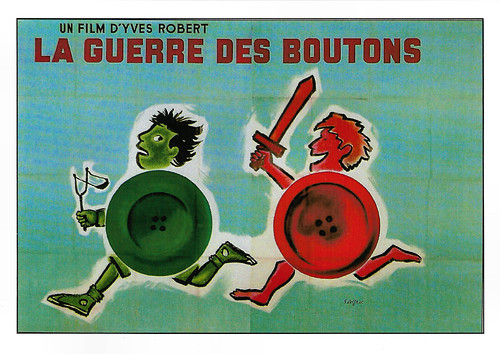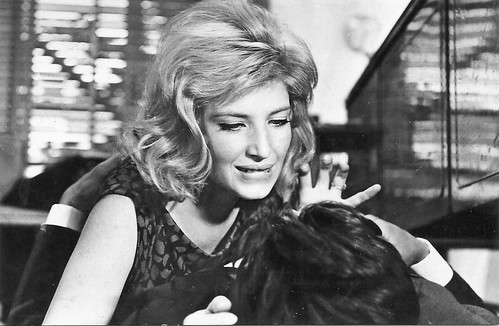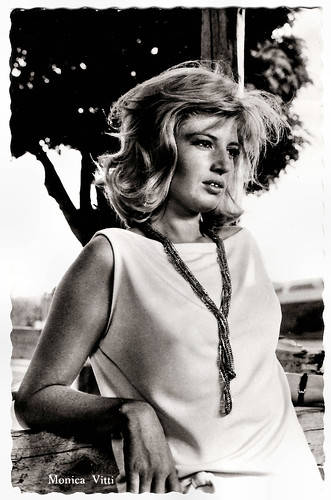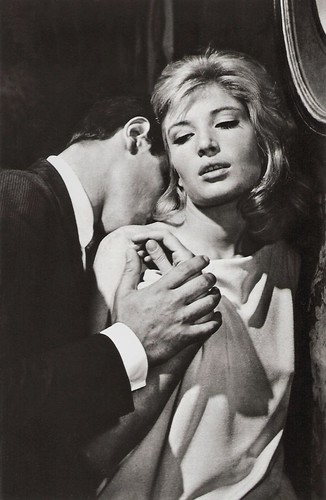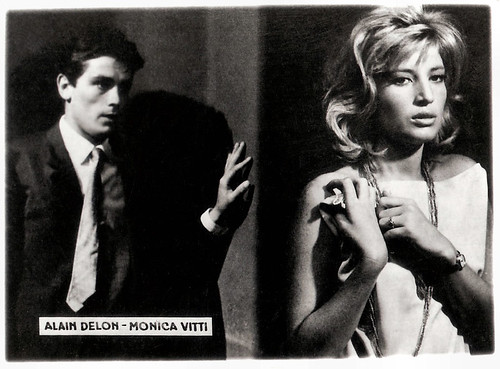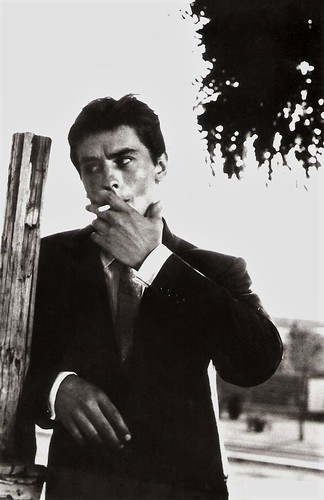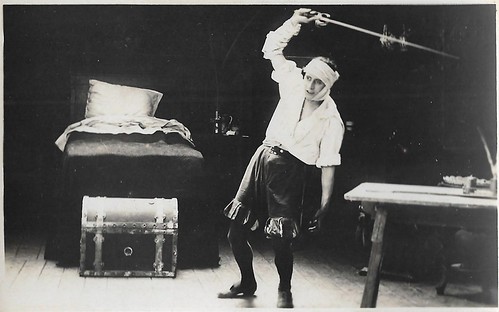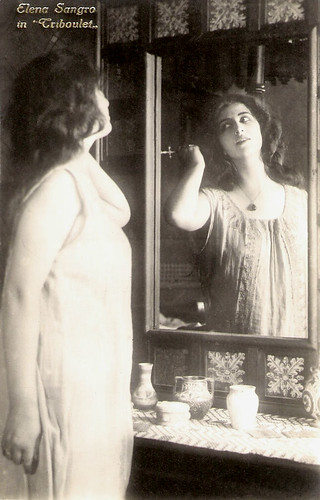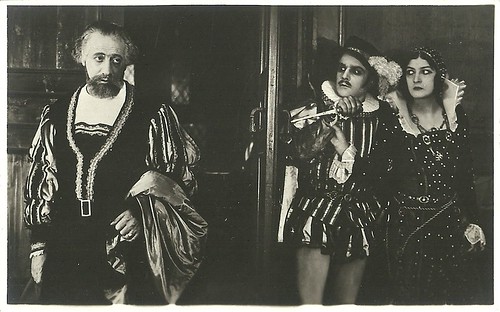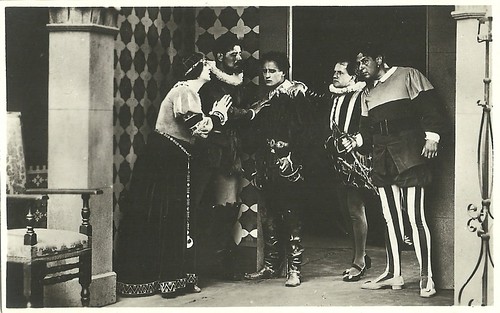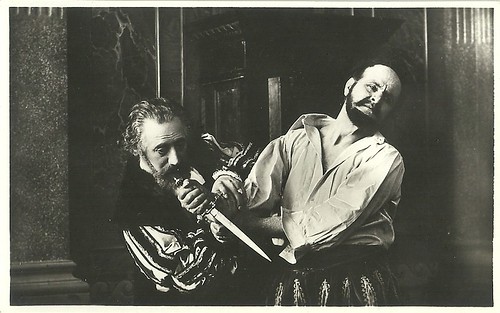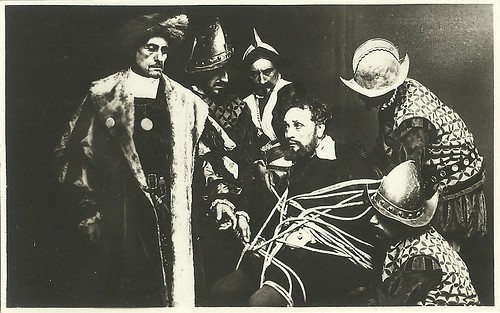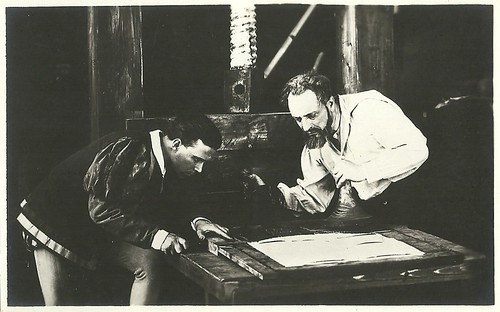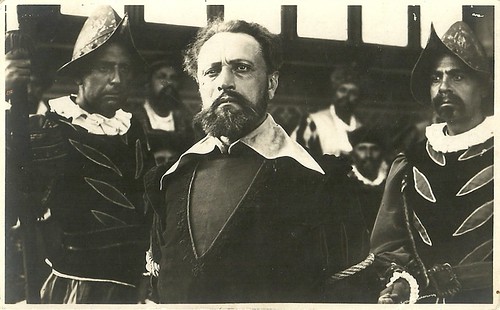
Vintage postcard. Richard Harris in A Man Called Horse (Elliot Silverstein, 1970).

Dutch postcard. Photo: Warner Bros. Richard Harris and Daniel Radcliffe in Harry Potter and the Sorcerer's Stone (Chris Columbus, 2001).
The quintessential angry young man
Richard St John Francis Harris was born in 1930 in Limerick, Ireland, to a farming family. He was the fifth of eight (or nine - the sources differ) children of Mildred (Harty) and Ivan Harris. He was educated by the Jesuits at Crescent College and was an excellent rugby player, with a strong passion for literature. Unfortunately, a bout of tuberculosis as a teenager ended his aspirations for a rugby career. He became fascinated with the theatre and skipped a local dance one night to attend a performance of 'Henry IV'. He was hooked and went on to learn his craft at the London Academy of Music and Dramatic Art (LAMDA).
While still a student, he rented the tiny 'off-West End' Irving Theatre in London and directed his own production of Clifford Odets' 'Winter Journey (The Country Girl)'. The critics approved, but the production used up all his savings. After completing his studies at the academy, he joined Joan Littlewood's Theatre Workshop. He began getting roles in West End theatre productions, starting with 'The Quare Fellow' in 1956, a transfer from the Theatre Workshop. He spent nearly a decade in obscurity, learning his profession on stages throughout the UK.
He debuted on screen in the British comedy Alive and Kicking (Cyril Frankel, 1959), starring Sybil Thorndike, followed by a small part in Shake Hands with the Devil (Michael Anderson, 1959), starring screen legend James Cagney. Harris quickly scored regular work in films, including The Wreck of the Mary Deare (Michael Anderson, 1959) with Gary Cooper and Charlton Heston, and A Terrible Beauty (Tay Garnett, 1960) opposite Robert Mitchum. He played a good role as a frustrated Australian bomber pilot in the all-star war epic The Guns of Navarone (J. Lee Thompson, 1961). In his youth, he had been a fan of Marlon Brando, but he did not get along with the American star while filming Mutiny on the Bounty (Lewis Milestone, Carol Reed, George Seaton, 1962). He blamed Brando's on-set behaviour for the film going over budget and over schedule.
Harris's breakthrough performance was as the quintessential 'angry young man' in the sensational drama This Sporting Life (Lindsay Anderson, 1963). His part as a bitter young coal miner, Frank Machin, who becomes an acclaimed rugby league football player, earned him an Oscar nomination. Also acclaimed was the Italian psychological drama Il deserto rosso / Red Desert (Michelangelo Antonioni, 1964) with Monica Vitti. Set in Northern Italy, the story follows a troubled woman who is unable to adapt to her environment after an automobile accident. Red Desert was awarded the Golden Lion at the 25th Venice International Film Festival in 1964. Harris then co-starred with Kirk Douglas in the WWII commando tale The Heroes of Telemark (Anthony Mann, 1965) and with Charlton Heston in the Western Major Dundee (Sam Peckinpah, 1965).
He next showed up in the musical Hawaii (George Roy Hill, Arthur Hiller, 1966) starring Julie Andrews, and played King Arthur in Camelot (Joshua Logan, 1967), a lacklustre adaptation of Alan Jay Lerner & Frederick Loewe's hit musical. He hated making the Spy spoof comedy Caprice (Frank Tashlin, 1967) with Doris Day so much that he never watched the film. Harris was the very first person to record Jimmy Webb's song 'MacArthur Park' and scored a number-one singing hit in Australia, Jamaica and Canada, and a top-ten hit in the United Kingdom, Ireland, and the United States, in 1968.
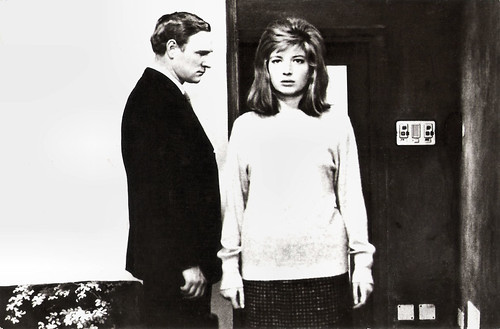
Romanian postcard by Casa Filmului Acin, no. 322. Photo: Monica Vitti and Richard Harris in Il deserto rosso / Red Desert (Michelangelo Antonioni, 1964).

Vintage postcard. Richard Harris in A Man Called Horse (Elliot Silverstein, 1970).
Headmaster Albus Dumbledore
At the height of his stardom in the 1960s and early 1970s, Richard Harris was almost as well known for his hellraiser lifestyle and heavy drinking as he was for his acting career. He played a fine role as a reluctant police informer in The Molly Maguires (Martin Ritt, 1970) alongside Sir Sean Connery. He took the lead role in the violent Western A Man Called Horse (Elliot Silverstein, 1970), which became a cult film and spawned two sequels. He portrayed Oliver Cromwell in the film Cromwell (Ken Hughes, 1970) opposite Alec Guinness as King Charles I of England. He directed himself as an ageing soccer player in Bloomfield (Richard Harris, Uri Zohar, 1970) with Romy Schneider. That year, British exhibitors voted him the 9th-most popular star at the UK box office.
Harris received an Emmy Award for his role in the British television drama The Snow Goose (Patrick Garland, 1971). As the 1970s progressed, Harris continued to appear regularly on screen, but the quality of the scripts varied from above average to woeful. His credits during this period included the Spaghetti Western The Deadly Trackers (Barry Shear, Samuel Fuller, 1973), the big-budget disaster film Juggernaut (Richard Lester, 1974) and the strangely-titled crime film 99 and 44/100% Dead! (John Frankenheimer, 1974). Sean Connery and Harris reunited in Robin and Marian (Richard Lester, 1976), also starring Audrey Hepburn. Harris had a cameo as Richard the Lionheart. He starred in the dated animated fantasy Gulliver's Travels (Peter R. Hunt, 1977) and in the Jaws rip-off Orca: The Killer Whale (Michael Anderson, 1977).
Richard Harris played an ill-fated mercenary with Richard Burton and Roger Moore in the action film The Wild Geese (Andrew V. McLaglen, 1978). He was a vocal supporter of the Provisional Irish Republican Army from 1973 to 1984. He was replaced by Donald Sutherland as IRA terrorist Liam Devlin in The Eagle Has Landed (John Sturges, 1976) after it was discovered that he had attended a fundraiser for the Provisional IRA in the US. He discontinued his support after the 1983 Harrods bombing and later became active in persuading Americans of Irish descent not to give money to terrorist groups. The 1980s kicked off with Harris appearing in the silly Bo Derek production Tarzan the Ape Man (John Derek, 1981). That year, Harris nearly died from alcoholism, and a Roman Catholic priest was called to give him the last rites. Harris went into semi-retirement on Paradise Island, in the Bahamas, where he kicked his drinking habit and embraced a healthier lifestyle. He gave up drinking completely, but returned to drinking Guinness a decade later. He later also said that he gave up drugs after almost overdosing on cocaine in 1978. In 1985, Harris became a born-again Catholic after his brother Dermot Harris died from alcoholism. In the mid-1980s, he was a guest professor at the University of Scranton, teaching Theatre Arts courses, but the remainder of the 1980s had him appearing in such forgettable productions as the American drama Martin's Day (Alan Gibson, 1985), Strike Commando 2 (Bruno Mattei, Claudio Fragasso, 1988), and King of the Wind (Peter Duffell, 1990).
Harris made a triumphant comeback when director Jim Sheridan cast him in the lead role in The Field (Jim Sheridan, 1990), written by the esteemed Irish playwright John B. Keane. The role of 'Bull' McCabe was originally to be played by Ray McAnally, but when McAnally suddenly died, Harris was offered the role. The Field was released in 1990 and earned Harris his second Academy Award nomination for Best Actor. He then locked horns with Harrison Ford as an IRA sympathiser in the political thriller Patriot Games (Phillip Noyce, 1992) and got one of his best roles as gunfighter English Bob in the Western Unforgiven (Clint Eastwood, 1992). Harris was firmly back in vogue. He gave wonderful performances in Wrestling Ernest Hemingway (Randa Haines, 1993) opposite Robert Duvall and Shirley MacLaine, Cry, the Beloved Country (Darrell Roodt, 1995) opposite James Earl Jones, the TV Movie The Great Kandinsky (Terry Winsor, 1995), and This Is the Sea (Mary McGuckian, 1997) starring Samantha Morton. Further fortune came his way with a strong performance as the Roman Emperor Marcus Aurelius in the blockbuster Gladiator (Ridley Scott, 2000) starring Russell Crowe.
Then he became known to an entirely new generation of film fans as Headmaster Albus Dumbledore in the mega-successful Harry Potter and the Sorcerer's Stone (Chris Columbus, 2001) and Harry Potter and the Chamber of Secrets (Chris Columbus, 2002). Harris hesitated to take the role of Dumbledore in Harry Potter and the Philosopher's Stone (2001) owing to the multi-film commitment and his declining health. He ultimately accepted because, according to his account of the story, his 11-year-old granddaughter threatened never to speak to him again if he did not take it. His final screen role was as Lucius Sulla in the TV Mini-series Julius Caesar (Uli Edel, 2002) with Christopher Walken as Cato and Jeremy Sisto as Julius Caesar. Richard Harris died of Hodgkin's disease, also known as Hodgkin's lymphoma, in London in 2002, aged 72. He was cremated, and his ashes were scattered at his home in the Bahamas. In 1957, Harris married Elizabeth Rees-Williams, and they had three sons: director Damian Harris, as well as actors Jared Harris and Jamie Harris. Harris and Rees-Williams divorced in 1969, after which Harris married American actress Ann Turkel in 1974. They divorced in 1982. He spent the last 12 years of his life living in Room 758 at the world-famous Savoy Hotel in London.

French postcard by Service Postal. Photo: Warner Bros. Richard Harris in Harry Potter and the Sorcerer's Stone (Chris Columbus, 2001).

Dutch postcard. Photo: Warner Bros. Richard Harris in Harry Potter and the Sorcerer's Stone (Chris Columbus, 2001).
Sources: Wikipedia (Dutch, German and English) and IMDb.








